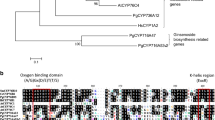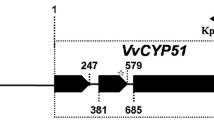Abstract
Structural mutations providing herbicide resistance may cause a modification of the three dimensional structure of a protein which will lead to a decrease in the herbicide efficacy. Wild oat (Avena ludoviciana Durieu.) is an increasingly disruptive weed in areas of intensive cereal production, thus the aim of this research was to identify mutations conferring resistance to ACCase-inhibitor herbicides at greenhouse, laboratory and in silico scales. Among the selected biotypes, No. 3 in the position 1781 (Ile1781-Leu) and No. 14 in the position 2041 (Ile2041-Asn), showed resistance to ACCase-inhibitor. The above mutations were confirmed using the specific primers and PCR-based methods. Analysis of molecular docking indicated that residues of Trp1948 and Pro2001 are important in the binding site and showed remarkable variation in the mutation types. Using molecular dynamic simulation analysis, we demonstrated that mutation types changed the conformation of the enzyme. These changes resulted in compressed conformation in the active site, which limited the availability of binding herbicide-enzyme. In present, no crystallography molecular structure and modeling reported on the ACCase of plants and this study investigated interactions of clodinafop propargyl and ACCase CT domain in A. ludoviciana by modeling, docking and simulations for the first time. Totally, bioinformatics analysis as well as PCR-based method confirmed that herbicide resistance conferred by nucleotide mutations in the gene sequence.







Similar content being viewed by others
References
Travlos IS, Giannopolitis CN (2010) Assessment of distribution and diversity of Avena sterilis L. and Avena fatua L. in cereal crops of Greece based on a 3-year survey and selected morphological traits. Genet Resour Crop Evol 57:337–341
Qasem J (2007) Chemical control of wild-oat (Avena sterilis L.) and other weeds in wheat (Triticum durum Desf.) in Jordan. Crop Protect 26:1315–1324
Heap I (2018) The international survey of herbicide resistant weeds. Online Internet Saturday, June 17, 2018. http://www.weedscience.org
Heap IM, Murray BG, Loeppky HA, Morrison IN (1993) Resistance to aryloxyphenoxypropionate and cyclohexanedione herbicides in wild oat (Avena fatua). Weed Sci 41:232–238
Délye C (2005) Weed resistance to acetyl coenzyme A carboxylase inhibitors: an update. Weed Sci 53:728–746
Harwood HJ (2005) Treating the metabolic syndrome: acetyl-CoA carboxylase inhibition. Expert Opin Ther Targets 9:267–281
Harwood HJ, Petras SF, Shelly LD, Zaccaro LM, Perry DA, Makowski MR, Hargrove DM, Martin KA, Tracey WR, Chapman JG (2003) Isozyme-nonselective N-substituted bipiperidylcarboxamide acetyl-CoA carboxylase inhibitors reduce tissue malonyl-CoA concentrations, inhibit fatty acid synthesis, and increase fatty acid oxidation in cultured cells and in experimental animals. J Biol Chem 278:37099–37111
Glund S, Schoelch C, Thomas L, Niessen H, Stiller D, Roth G, Neubauer H (2012) Inhibition of acetyl-CoA carboxylase 2 enhances skeletal muscle fatty acid oxidation and improves whole-body glucose homeostasis in db/db mice. Diabetologia 55:2044–2053
Powles SB, Yu Q (2010) Evolution in action: plants resistant to herbicides. Annu Rew Plant Biol 61:317–347
Beckie HJ, Warwick SI, Sauder CA (2012) Basis for herbicide resistance in Canadian populations of wild oat (Avena fatua). Weed Sci 60:10–18
Zhang XQ, Powles SB (2006) Six amino acid substitutions in the carboxyl-transferase domain of the plastidic acetyl-CoA carboxylase gene are linked with resistance to herbicides in a Lolium rigidum population. New Phytol 172:636–645
Délye C, Pernin F, Michel S (2011) ‘Universal’PCR assays detecting mutations in acetyl-coenzyme A carboxylase or acetolactate synthase that endow herbicide resistance in grass weeds. Weed Res 51:353–362
Délye C, Zhang XQ, Michel S, Matéjicek A, Powles SB (2005) Molecular bases for sensitivity to acetyl-coenzyme A carboxylase inhibitors in black-grass. Plant Physiol 137:794–806
Halperin I, Ma B, Wolfson H, Nussinov R (2002) Principles of docking: An overview of search algorithms and a guide to scoring functions. Proteins 47:409–443
Clark AJ, Tiwary P, Borrelli K, Feng S, Miller EB, Abel R, Friesner RA, Berne BJ (2016) Prediction of protein-ligand binding poses via a combination of induced fit docking and metadynamics simulations. J Chem Theory Comput 12:2990–2998
Raval A, Piana S, Eastwood MP, Shaw DE (2016) Assessment of the utility of contact-based restraints in accelerating the prediction of protein structure using molecular dynamics simulations. Protein Sci 25:19–29
Schneider S, Provasi D, Saylor R, Prisinzano T, Filizola M (2016) Predicted mode of binding of non-nitrogenous µ-opioid receptor ligands by metadynamics. Biophys J 110:90a
Franca EF, Leite FL, Cunha RA, Oliveira ON Jr, Freitas LC (2011) Designing an enzyme-based nanobiosensor using molecular modeling techniques. Phys Chem Chem Phys 13:8894–8899
Ramalho TC, Caetano MS, da Cunha EF, Souza TC, Rocha MV (2009) Construction and assessment of reaction models of class I EPSP synthase: molecular docking and density functional theoretical calculations. J Biomol Struct Dyn 27:195–207
Zhang H, Tweel B, Tong L (2004) Molecular basis for the inhibition of the carboxyltransferase domain of acetyl-coenzyme-A carboxylase by haloxyfop and diclofop. Proc Natl Acad Sci USA 101:5910–5915
Yu Q, Ahmad-Hamdani M, Han H, Christoffers M, Powles S (2013) Herbicide resistance-endowing ACCase gene mutations in hexaploid wild oat (Avena fatua): insights into resistance evolution in a hexaploid species. Heredity 110:220–231
Doyle JJ, Doyle JL (1990) Isolation of plant DNA from fresh tissue. Focus 12:13–15
Laskowski RA, MacArthur MW, Moss DS, Thornton JM (1993) PROCHECK: a program to check the stereochemical quality of protein structures. J Appl Crystallogr 26:283–291
Laskowski RA, Rullmann JAC, MacArthur MW, Kaptein R, Thornton JM (1996) AQUA and PROCHECK-NMR: programs for checking the quality of protein structures solved by NMR. J Biomol NMR 8:477–486
Trott O, Olson AJ (2010) AutoDock Vina: improving the speed and accuracy of docking with a new scoring function, efficient optimization, and multithreading. J Comput Chem 31:455–461
Rashad AA, Keller PA (2013) Structure based design towards the identification of novel binding sites and inhibitors for the chikungunya virus envelope proteins. J Mol Graph Model 44:241–252
Humphrey W, Dalke A, Schulten K (1996) VMD: visual molecular dynamics. J Mol Graph 14:33–38
Laskowski RA (2009) PDBsum new things. Nucleic Acid Res 37:D355–D359
Van Der Spoel D, Lindahl E, Hess B, Groenhof G, Mark AE, Berendsen HJ (2005) GROMACS: fast, flexible, and free. J Comput Chem 26:1701–1718
Berendsen HJ, Postma Jv, van Gunsteren WF, DiNola A, Haak J (1984) Molecular dynamics with coupling to an external bath. J Chem Phys 81:3684–3690
Hess B, Bekker H, Berendsen HJ, Fraaije JG (1997) LINCS: a linear constraint solver for molecular simulations. J Comput Chem 18:1463–1472
Essmann U, Perera L, Berkowitz ML, Darden T, Lee H, Pedersen LG (1995) A smooth particle mesh Ewald method. J Chem Phys 103:8577–8593
Yang J, Wang Y, Zhang Y (2016) ResQ: an approach to unified estimation of B-factor and residue-specific error in protein structure prediction. J Mol Biol 428:693–701
Naômé A, Schyman P, Laaksonen A, Vercauteren DP (2010) Molecular dynamics simulation of 8-oxoguanine containing DNA fragments reveals altered hydration and ion binding patterns. J Phys Chem B 114:4789–4801
Beckie HJ, Johnson EN, Leeson JY, Shirriff SW, Kapiniak A (2014) Selection and evolution of acetyl-CoA carboxylase (ACC)-inhibitor resistance in wild oat (Avena fatua L.) in a long-term alternative cropping systems study. Can J Plant Sci 94:727–731
Cruz-Hipolito H, Osuna MD, Domínguez-Valenzuela JA, Espinoza N, De Prado R (2011) Mechanism of resistance to ACCase-inhibiting herbicides in wild oat (Avena fatua) from Latin America. J Agri Food Chem 59:7261–7267
Zagnitko O, Jelenska J, Tevzadze G, Haselkorn R, Gornicki P (2001) An isoleucine/leucine residue in the carboxyltransferase domain of acetyl-CoA carboxylase is critical for interaction with aryloxyphenoxypropionate and cyclohexanedione inhibitors. Proc Natl Acad Sci 98:6617–6622
Délye C, Zhang XQ, Chalopin C, Michel S, Powles SB (2003) An isoleucine residue within the carboxyl-transferase domain of multidomain acetyl-coenzyme A carboxylase is a major determinant of sensitivity to aryloxyphenoxypropionate but not to cyclohexanedione inhibitors. Plant Physiol 132:1716–1723
Delye C, Matejicek A, Gasquez J (2002) PCR-based detection of resistance to acetyl-CoA carboxylase-inhibiting herbicides in black-grass (Alopecurus myosuroides Huds) and ryegrass (Lolium rigidum Gaud). Pest Manag Sci 58:474–478
Gaines TA, Zhang W, Wang D, Bukun B, Chisholm ST, Shaner DL, Nissen SJ, Patzoldt WL, Tranel PJ, Culpepper AS (2010) Gene amplification confers glyphosate resistance in Amaranthus palmeri. Proc Natl Acad Sci 107:1029–1034
Délye C, Straub C, Michel S, Le Corre V (2004) Nucleotide variability at the acetyl coenzyme A carboxylase gene and the signature of herbicide selection in the grass weed Alopecurus myosuroides (Huds.). Mol Biol Evol 21:884–892
Linda P, Kim YS, Tong L (2010) Mechanism for the inhibition of the carboxyltransferase domain of acetyl-coenzyme A carboxylase by pinoxaden. Proc Natl Acad Sci 107:22072–22077
Kaundun S, Windass J (2006) Derived cleaved amplified polymorphic sequence, a simple method to detect a key point mutation conferring acetyl CoA carboxylase inhibitor herbicide resistance in grass weeds. Weed Res 46:34–39
Liu W, Harrison DK, Chalupska D, Gornicki P, O’Donnell CC, Adkins SW, Haselkorn R, Williams RR (2007) Single-site mutations in the carboxyltransferase domain of plastid acetyl-CoA carboxylase confer resistance to grass-specific herbicides. Proc Natl Acad Sci 104:3627–3632
Choe M, Choe W, Lee I, Wu M, Liu S (2015) Computational analysis of mutated AHAS in response to sulfonylurea herbicides. Weed Res 55:359–369
Sasanfar H, Zand E, Baghestani MA, Mirhadi MJ, Mesgaran MB (2017) Cross-resistance patterns of winter wild oat (Avena ludoviciana) populations to ACCase inhibitor herbicides. Phytoparasitica 45:419–428
Author information
Authors and Affiliations
Corresponding author
Ethics declarations
Conflict of interest
The authors declare that they have no conflict of interest.
Rights and permissions
About this article
Cite this article
Akbarabadi, A., Ismaili, A., Kahrizi, D. et al. Resistance determination of the ACCase-inhibiting herbicide of clodinafop propargyl in Avena ludoviciana (Durieu), and study of their interaction using molecular docking and simulation. Mol Biol Rep 46, 415–424 (2019). https://doi.org/10.1007/s11033-018-4489-9
Received:
Accepted:
Published:
Issue Date:
DOI: https://doi.org/10.1007/s11033-018-4489-9




